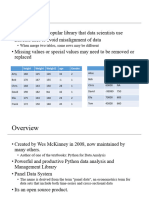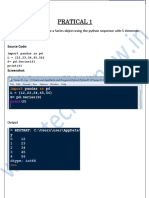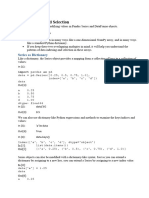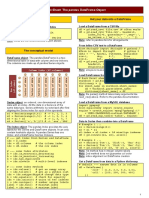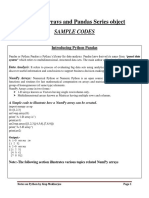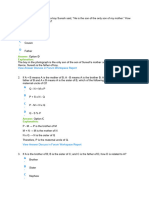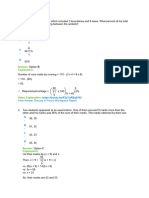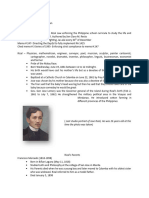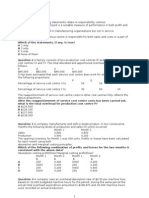9/8/2018 Jupyter Notebook Viewer
Pandas
Pandas contains high level data structures and manipulation tools to make data analysis fast and easy in
Python.
In [2]:
import pandas as pd #I am importing pandas as pd
from pandas import Series, DataFrame # Series and Data Frame are two data structures a
Series
Series is a one-dimensional array like object containing an array of data(any Numpy data type, and an
associated array of data labels, called its index.
In [13]:
mjp= Series([5,4,3,2,1])# a simple series
print mjp # A series is represented by index on the left and values on the righ
print mjp.values # similar to dictionary. ".values" command returns values in a series
0 5
1 4
2 3
3 2
4 1
dtype: int64
[5 4 3 2 1]
In [14]:
print mjp.index # returns the index values of the series
Int64Index([0, 1, 2, 3, 4], dtype='int64')
http://nbviewer.jupyter.org/gist/manujeevanprakash/996d18985be612072ee0 1/17
�9/8/2018 Jupyter Notebook Viewer
In [27]:
jeeva = Series([5,4,3,2,1,-7,-29], index =['a','b','c','d','e','f','h']) # The index i
print jeeva # try jeeva.index and jeeva.values
print jeeva['a'] # selecting a particular value from a Series, by using index
a 5
b 4
c 3
d 2
e 1
f -7
h -29
dtype: int64
5
In [28]:
jeeva['d'] = 9 # change the value of a particular element in series
print jeeva
jeeva[['a','b','c']] # select a group of values
a 5
b 4
c 3
d 9
e 1
f -7
h -29
dtype: int64
Out[28]:
a 5
b 4
c 3
dtype: int64
In [31]:
print jeeva[jeeva>0] # returns only the positive values
print jeeva *2 # multiplies 2 to each element of a series
a 5
b 4
c 3
d 9
e 1
dtype: int64
a 10
b 8
c 6
d 18
e 2
f -14
h -58
dtype: int64
http://nbviewer.jupyter.org/gist/manujeevanprakash/996d18985be612072ee0 2/17
�9/8/2018 Jupyter Notebook Viewer
In [34]:
import numpy as np
np.mean(jeeva) # you can apply numpy functions to a Series
Out[34]:
-2.0
In [37]:
print 'b' in jeeva # checks whether the index is present in Series or not
print 'z' in jeeva
True
False
In [46]:
player_salary ={'Rooney': 50000, 'Messi': 75000, 'Ronaldo': 85000, 'Fabregas':40000, '
new_player = Series(player_salary)# converting a dictionary to a series
print new_player # the series has keys of a dictionary
Fabregas 40000
Messi 75000
Ronaldo 85000
Rooney 50000
Van persie 67000
dtype: int64
In [49]:
players =['Klose', 'Messi', 'Ronaldo', 'Van persie', 'Ballack']
player_1 =Series(player_salary, index= players)
print player_1 # I have changed the index of the Series. Since, no value was not found
Klose NaN
Messi 75000
Ronaldo 85000
Van persie 67000
Ballack NaN
dtype: float64
In [53]:
pd.isnull(player_1)#checks for Null values in player_1, pd denotes a pandas dataframe
Out[53]:
Klose True
Messi False
Ronaldo False
Van persie False
Ballack True
dtype: bool
http://nbviewer.jupyter.org/gist/manujeevanprakash/996d18985be612072ee0 3/17
�9/8/2018 Jupyter Notebook Viewer
In [52]:
pd.notnull(player_1)# Checks for null values that are not Null
Out[52]:
Klose False
Messi True
Ronaldo True
Van persie True
Ballack False
dtype: bool
In [64]:
player_1.name ='Bundesliga players' # name for the Series
player_1.index.name='Player names' #name of the index
player_1
Out[64]:
Player names
Klose NaN
Messi 75000
Ronaldo 85000
Van persie 67000
Ballack NaN
Name: Bundesliga players, dtype: float64
In [67]:
player_1.index =['Neymar', 'Hulk', 'Pirlo', 'Buffon', 'Anderson'] # is used to alter t
player_1
Out[67]:
Neymar NaN
Hulk 75000
Pirlo 85000
Buffon 67000
Anderson NaN
Name: Bundesliga players, dtype: float64
Data Frame
Data frame is a spread sheet like structure, containing ordered collection of columns. Each column can
have different value type. Data frame has both row index and column index.
http://nbviewer.jupyter.org/gist/manujeevanprakash/996d18985be612072ee0 4/17
�9/8/2018 Jupyter Notebook Viewer
In [74]:
states ={'State' :['Gujarat', 'Tamil Nadu', ' Andhra', 'Karnataka', 'Kerala'],
'Population': [36, 44, 67,89,34],
'Language' :['Gujarati', 'Tamil', 'Telugu', 'Kannada', 'Malayalam']}
india = DataFrame(states) # creating a data frame
india
Out[74]:
Language Population State
0 Gujarati 36 Gujarat
1 Tamil 44 Tamil Nadu
2 Telugu 67 Andhra
3 Kannada 89 Karnataka
4 Malayalam 34 Kerala
In [75]:
DataFrame(states, columns=['State', 'Language', 'Population']) # change the sequence of
Out[75]:
State Language Population
0 Gujarat Gujarati 36
1 Tamil Nadu Tamil 44
2 Andhra Telugu 67
3 Karnataka Kannada 89
4 Kerala Malayalam 34
In [82]:
new_farme = DataFrame(states, columns=['State', 'Language', 'Population', 'Per Capita
#if you pass a column that isnt in states, it will appear with Na values
In [86]:
print new_farme.columns
print new_farme['State'] # retrieveing data like dictionary
Index([u'State', u'Language', u'Population', u'Per Capita Income'], dtype=
a Gujarat
b Tamil Nadu
c Andhra
d Karnataka
e Kerala
Name: State, dtype: object
http://nbviewer.jupyter.org/gist/manujeevanprakash/996d18985be612072ee0 5/17
�9/8/2018 Jupyter Notebook Viewer
In [89]:
new_farme.Population # like Series
Out[89]:
a 36
b 44
c 67
d 89
e 34
Name: Population, dtype: int64
In [91]:
new_farme.ix[3] # rows can be retrieved using .ic function
# here I have retrieved 3rd row
Out[91]:
State Karnataka
Language Kannada
Population 89
Per Capita Income NaN
Name: d, dtype: object
In [94]:
new_farme
Out[94]:
State Language Population Per Capita Income
a Gujarat Gujarati 36 NaN
b Tamil Nadu Tamil 44 NaN
c Andhra Telugu 67 NaN
d Karnataka Kannada 89 NaN
e Kerala Malayalam 34 NaN
In [97]:
new_farme['Per Capita Income'] = 99 # the empty per capita income column can be assign
new_farme
Out[97]:
State Language Population Per Capita Income
a Gujarat Gujarati 36 99
b Tamil Nadu Tamil 44 99
c Andhra Telugu 67 99
d Karnataka Kannada 89 99
e Kerala Malayalam 34 99
http://nbviewer.jupyter.org/gist/manujeevanprakash/996d18985be612072ee0 6/17
�9/8/2018 Jupyter Notebook Viewer
In [99]:
new_farme['Per Capita Income'] = np.arange(5) # assigning a value to the last column
new_farme
Out[99]:
State Language Population Per Capita Income
a Gujarat Gujarati 36 0
b Tamil Nadu Tamil 44 1
c Andhra Telugu 67 2
d Karnataka Kannada 89 3
e Kerala Malayalam 34 4
In [104]:
series = Series([44,33,22], index =['b','c','d'])
new_farme['Per Capita Income'] = series
#when assigning list or arrays to a column, the values lenght should match the length
new_farme # again the missing values are displayed as NAN
Out[104]:
State Language Population Per Capita Income
a Gujarat Gujarati 36 NaN
b Tamil Nadu Tamil 44 44
c Andhra Telugu 67 33
d Karnataka Kannada 89 22
e Kerala Malayalam 34 NaN
http://nbviewer.jupyter.org/gist/manujeevanprakash/996d18985be612072ee0 7/17
�9/8/2018 Jupyter Notebook Viewer
In [119]:
new_farme['Development'] = new_farme.State == 'Gujarat'# assigning a new column
print new_farme
del new_farme['Development'] # will delete the column 'Development'
new_farme
State Language Population Per Capita Income Development
a Gujarat Gujarati 36 NaN True
b Tamil Nadu Tamil 44 44 False
c Andhra Telugu 67 33 False
d Karnataka Kannada 89 22 False
e Kerala Malayalam 34 NaN False
Out[119]:
State Language Population Per Capita Income
a Gujarat Gujarati 36 NaN
b Tamil Nadu Tamil 44 44
c Andhra Telugu 67 33
d Karnataka Kannada 89 22
e Kerala Malayalam 34 NaN
In [16]:
new_data ={'Modi': {2010: 72, 2012: 78, 2014 : 98},'Rahul': {2010: 55, 2012: 34, 2014:
elections = DataFrame(new_data)
print elections# the outer dict keys are columns and inner dict keys are rows
elections.T # transpose of a data frame
Modi Rahul
2010 72 55
2012 78 34
2014 98 22
Out[16]:
2010 2012 2014
Modi 72 78 98
Rahul 55 34 22
In [17]:
DataFrame(new_data, index =[2012, 2014, 2016]) # you can assign index for the data fra
Out[17]:
Modi Rahul
2012 78 34
2014 98 22
2016 NaN NaN
http://nbviewer.jupyter.org/gist/manujeevanprakash/996d18985be612072ee0 8/17
�9/8/2018 Jupyter Notebook Viewer
In [18]:
ex= {'Gujarat':elections['Modi'][:-1], 'India': elections['Rahul'][:2]}
px =DataFrame(ex)
px
Out[18]:
Gujarat India
2010 72 55
2012 78 34
In [150]:
from IPython.display import Image
i = Image(filename='Constructors.png')
i # list of things you can pass to a dataframe
Out[150]:
In [155]:
px.index.name = 'year'
px.columns.name = 'politicians'
px
Out[155]:
politicians Gujarat India
year
2010 72 55
2012 78 34
http://nbviewer.jupyter.org/gist/manujeevanprakash/996d18985be612072ee0 9/17
�9/8/2018 Jupyter Notebook Viewer
In [156]:
px.values
Out[156]:
array([[72, 55],
[78, 34]], dtype=int64)
In [3]:
jeeva = Series([5,4,3,2,1,-7,-29], index =['a','b','c','d','e','f','h'])
index = jeeva.index
print index #u denotes unicode
print index[1:]# returns all the index elements except a.
index[1] = 'f' # you cannot modify an index element. It will generate an error. In oth
--------------------------------------------------------------------------
TypeError Traceback (most recent call last
<ipython-input-3-e8b7ee2d0552> in <module>()
3 print index #u denotes unicode
4 print index[1:]# returns all the index elements except a.
----> 5 index[1] = 'f' # you cannot modify an index element. It will gener
C:\Users\tk\AppData\Local\Enthought\Canopy32\User\lib\site-packages\pandas
177 """This method will not function because object is immutab
178 raise TypeError("'%s' does not support mutable operations.
--> 179 self.__class__)
180
181 __setitem__ = __setslice__ = __delitem__ = __delslice__ = _dis
TypeError: '<class 'pandas.core.index.Index'>' does not support mutable op
Index([u'a', u'b', u'c', u'd', u'e', u'f', u'h'], dtype='object')
Index([u'b', u'c', u'd', u'e', u'f', u'h'], dtype='object')
In [22]:
print px
2013 in px.index # checks if 2003 is an index in data frame px
Gujarat India
2010 72 55
2012 78 34
Out[22]:
False
Reindex
http://nbviewer.jupyter.org/gist/manujeevanprakash/996d18985be612072ee0 10/17
�9/8/2018 Jupyter Notebook Viewer
In [27]:
var = Series(['Python', 'Java', 'c', 'c++', 'Php'], index =[5,4,3,2,1])
print var
var1 = var.reindex([1,2,3,4,5])# reindex creates a new object
print var1
5 Python
4 Java
3 c
2 c++
1 Php
dtype: object
1 Php
2 c++
3 c
4 Java
5 Python
dtype: object
In [28]:
var.reindex([1,2,3,4,5,6,7])# introduces new indexes with values Nan
Out[28]:
1 Php
2 c++
3 c
4 Java
5 Python
6 NaN
7 NaN
dtype: object
In [31]:
var.reindex([1,2,3,4,5,6,7], fill_value =1) # you can use fill value to fill the Nan v
Out[31]:
1 Php
2 c++
3 c
4 Java
5 Python
6 1
7 1
dtype: object
http://nbviewer.jupyter.org/gist/manujeevanprakash/996d18985be612072ee0 11/17
�9/8/2018 Jupyter Notebook Viewer
In [35]:
gh =Series(['Dhoni', 'Sachin', 'Kohli'], index =[0,2,4])
print gh
gh.reindex(range(6), method ='ffill') #ffill is forward fill. It forward fills the val
0 Dhoni
2 Sachin
4 Kohli
dtype: object
Out[35]:
0 Dhoni
1 Dhoni
2 Sachin
3 Sachin
4 Kohli
5 Kohli
dtype: object
In [36]:
gh.reindex(range(6), method ='bfill')# bfill, backward fills the values
Out[36]:
0 Dhoni
1 Sachin
2 Sachin
3 Kohli
4 Kohli
5 NaN
dtype: object
In [45]:
import numpy as np
fp = DataFrame(np.arange(9).reshape((3,3)),index =['a','b','c'], columns =['Gujarat','
fp
Out[45]:
Gujarat Tamil Nadu Kerala
a 0 1 2
b 3 4 5
c 6 7 8
http://nbviewer.jupyter.org/gist/manujeevanprakash/996d18985be612072ee0 12/17
�9/8/2018 Jupyter Notebook Viewer
In [55]:
fp1 =fp.reindex(['a', 'b', 'c', 'd'], columns = states) # reindexing columns and indic
fp1
Out[55]:
Gujarat Assam Kerala
a 0 NaN 2
b 3 NaN 5
c 6 NaN 8
d NaN NaN NaN
Other Reindexing arguments
limit When forward- or backfilling, maximum size gap to fill
level Match simple Index on level of MultiIndex, otherwise select subset of
copy Do not copy underlying data if new index is equivalent to old index. True by default (i.e. always copy
data).
Dropping entries from an axis
In [62]:
er = Series(np.arange(5), index =['a','b','c','d','e'])
print er
er.drop(['a','b']) #drop method will return a new object with values deleted from an
a 0
b 1
c 2
d 3
e 4
dtype: int32
Out[62]:
c 2
d 3
e 4
dtype: int32
http://nbviewer.jupyter.org/gist/manujeevanprakash/996d18985be612072ee0 13/17
�9/8/2018 Jupyter Notebook Viewer
In [77]:
states ={'State' :['Gujarat', 'Tamil Nadu', ' Andhra', 'Karnataka', 'Kerala'],
'Population': [36, 44, 67,89,34],
'Language' :['Gujarati', 'Tamil', 'Telugu', 'Kannada', 'Malayalam']}
india = DataFrame(states, columns =['State', 'Population', 'Language'])
print india
india.drop([0,1])# will drop index 0 and 1
State Population Language
0 Gujarat 36 Gujarati
1 Tamil Nadu 44 Tamil
2 Andhra 67 Telugu
3 Karnataka 89 Kannada
4 Kerala 34 Malayalam
Out[77]:
State Population Language
2 Andhra 67 Telugu
3 Karnataka 89 Kannada
4 Kerala 34 Malayalam
In [82]:
india.drop(['State', 'Population'], axis =1 )# the function dropped population and sta
Out[82]:
Language
0 Gujarati
1 Tamil
2 Telugu
3 Kannada
4 Malayalam
Selection, Indexing and Filtering
In [102]:
var = Series(['Python', 'Java', 'c', 'c++', 'Php'], index =[5,4,3,2,1])
var
Out[102]:
5 Python
4 Java
3 c
2 c++
1 Php
dtype: object
http://nbviewer.jupyter.org/gist/manujeevanprakash/996d18985be612072ee0 14/17
�9/8/2018 Jupyter Notebook Viewer
In [103]:
print var[5]
print var[2:4]
Python
3 c
2 c++
dtype: object
In [104]:
var[[3,2,1]]
Out[104]:
3 c
2 c++
1 Php
dtype: object
In [109]:
var[var == 'Php']
Out[109]:
1 Php
dtype: object
In [111]:
states ={'State' :['Gujarat', 'Tamil Nadu', ' Andhra', 'Karnataka', 'Kerala'],
'Population': [36, 44, 67,89,34],
'Language' :['Gujarati', 'Tamil', 'Telugu', 'Kannada', 'Malayalam']}
india = DataFrame(states, columns =['State', 'Population', 'Language'])
india
Out[111]:
State Population Language
0 Gujarat 36 Gujarati
1 Tamil Nadu 44 Tamil
2 Andhra 67 Telugu
3 Karnataka 89 Kannada
4 Kerala 34 Malayalam
http://nbviewer.jupyter.org/gist/manujeevanprakash/996d18985be612072ee0 15/17
�9/8/2018 Jupyter Notebook Viewer
In [114]:
india[['Population', 'Language']] # retrieve data from data frame
Out[114]:
Population Language
0 36 Gujarati
1 44 Tamil
2 67 Telugu
3 89 Kannada
4 34 Malayalam
In [115]:
india[india['Population'] > 50] # returns data for population greater than 50
Out[115]:
State Population Language
2 Andhra 67 Telugu
3 Karnataka 89 Kannada
In [117]:
india[:3] # first three rows
Out[117]:
State Population Language
0 Gujarat 36 Gujarati
1 Tamil Nadu 44 Tamil
2 Andhra 67 Telugu
http://nbviewer.jupyter.org/gist/manujeevanprakash/996d18985be612072ee0 16/17
�9/8/2018 Jupyter Notebook Viewer
In [4]:
# for selecting specific rows and columns, you can use ix function
import pandas as pd
states ={'State' :['Gujarat', 'Tamil Nadu', ' Andhra', 'Karnataka', 'Kerala'],
'Population': [36, 44, 67,89,34],
'Language' :['Gujarati', 'Tamil', 'Telugu', 'Kannada', 'Malayalam']}
india = DataFrame(states, columns =['State', 'Population', 'Language'], index =['a', '
india
Out[4]:
State Population Language
a Gujarat 36 Gujarati
b Tamil Nadu 44 Tamil
c Andhra 67 Telugu
d Karnataka 89 Kannada
e Kerala 34 Malayalam
In [128]:
india.ix[['a','b'], ['State','Language']] # this is how you select subset of rows
Out[128]:
State Language
a Gujarat Gujarati
b Tamil Nadu Tamil
http://nbviewer.jupyter.org/gist/manujeevanprakash/996d18985be612072ee0 17/17
